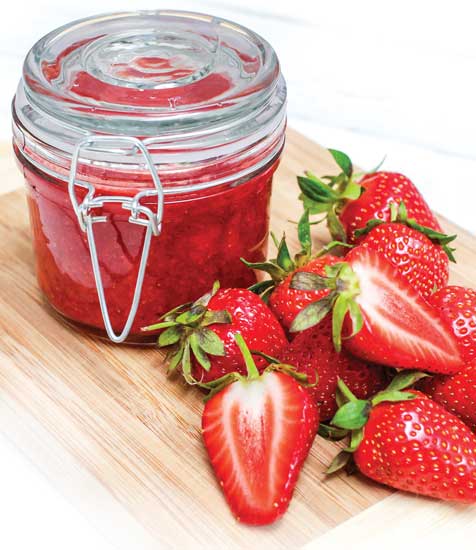Studying strawberry jam preferences; Generational eating patterns
NEWS
Examining generational eating patterns
Age, ethnicity, life stage, and values influence current and future eating behaviors, according to a recently released study by the NPD Group that compiles 30 years of consumption data to quantitatively examine eating patterns among the generations.
According to NPD’s A Generational Study: The Evolution of Eating, there are some cross-generational shifts in eating patterns, such as moving away from sugar and red meat and embracing convenient and healthy snacks. Some patterns do differ by generation, such as Millennial parents’ lesser conversion to kid-friendly foods compared with prior generations and their preference for healthy foods. Boomers, meanwhile, are choosing convenience and dining out more often than Millennials.
“It is undeniable that people of different ages have different eating patterns,” says David Portalatin, vice-president, food industry analyst at NPD Group. “The more important questions we must answer are whether these differences are the results of current life stage and circumstance, or whether an emerging set of new values will have the power to transcend life stage or circumstance. This analysis helps identify the unpredictable behaviors that will be the white space opportunities in the future.”
 Identifying preferences for strawberry jam
Identifying preferences for strawberry jam
As the production period for strawberries grown in subtropical regions reaches an end, rising temperatures mean that postharvest durability of the fruit can be compromised. One solution to using this fruit quickly while still fresh is to turn the strawberries into jams and jellies.
A recent Journal of Food Science study examined which cultivars are best-suited for processing into jelly. The study examined the physicochemical characteristics, rheological properties, and sensory acceptance of different strawberry cultivars grown in subtropical regions of Brazil, including Camarosa, Festival, San Andreas, Oso Grande, Camino Real, and Albion.
The researchers concluded that while all cultivars have the potential to be processed in the form of jams and jellies due to good acceptance of all formulations prepared, consumers generally prefer a lighter-colored jelly with a less intense red color, higher acidity, and less firmness.
New act to reduce food waste
On May 18, U.S. Senator Richard Blumenthal and Congresswoman Chellie Pingree introduced the Food Date Labeling Act, a measure that is intended to standardize language on food labels, which can confuse consumers and lead to food waste, according to a press release about the act.
Product dating is not generally federally required, says IFT member and Certified Food Scientist Linda Harris, specialist in cooperative extension at University of California, Davis, though food dating is a common practice. “Some states require dating of some foods, but the guidance is not consistent. Typically, a calendar date is given with a month, day, and possibly year, along with one of many possibilities, including ‘sell by,’ ‘use by,’ ‘best quality by,’ and ‘enjoy by,’” she explains.
“Food labels are seen, appropriately I think, as one of the barriers to reducing food waste,” observes Marsha Cohen, The Honorable Raymond L. Sullivan Professor of Law at the University of California, Hastings, and founding executive director of Lawyers for America. “Consumers are confused by dates that they think are telling them not to buy or not to use after a certain time, even if those are quality dates and chosen entirely by the food sellers.”
In this bill, she explains, packages might have two dates: a “best if used by” date would estimate the point when the quality of the food cannot be guaranteed by the manufacturer, and a safety date would indicate when food becomes unsafe to eat and would be required on labels.
Under this bill, food donation efforts could be made easier. Currently, some sellers do not want to risk donating food for fear of liability issues. If the act passes, foods that maintain their safety dates could still be donated even if they are past their quality dates. “The word ‘expiring’ is one that is confusing—and that this bill hopes to change. Foods can be safe even though they are no longer the highest quality,” Cohen says.
“If consumers have clear information, they can be better about using up products reaching their safety dates—while not just tossing out products that are reaching or beyond their quality,” says Cohen. “The hope is that education around uniform labeling will get everyone who may now be throwing out perfectly safe food to get it sold, given away, or used—no longer wasted.”
--- PAGE BREAK ---
 Lentils, chickpeas as burger binders
Lentils, chickpeas as burger binders
A Journal of Food Science study investigated the effects of adding micronized chickpea and green lentil flour to burgers. These flours can add nutritional benefits to burgers, but they are susceptible to oxidation due to the reaction of lipoxygenase (LOX) with linolenic and linoleic acids, which can lead to off-flavors caused by the formation of volatile organic compounds (VOCs).
In the study, researchers applied infrared micronization at 130°C and 150°C to determine its effect on LOX activity and VOCs of chickpea and green lentil flour, then added them to low-fat beef burgers at 6% and measured for consumer acceptability and physicochemical properties. Burgers with green lentil flour micronized at 130°C and 150°C and chickpea flour micronized at 150°C were positively associated with acceptability, and at 150°C, burgers with lentil and chickpea flours had significantly increased omega-3 and omega-6 fatty acids, respectively. In addition, micronization did not affect the shear force and cooking losses of the burgers made with either of the flours. Researchers conclude that these flours are suitable for use as binders.
Keeping consumers informed
There is a disconnect between the foods consumers purchase and their knowledge of how foods are made, according to Robert Post, chief scientific officer for Chobani, who spoke as part of a panel during the 2016 Global Midwest Alliance’s Innovation, Growth, and Globalization series this spring. Citing a lack of literacy, Post noted that consumers want to know what’s in their food, but they don’t necessarily know how to cook, so they must trust manufacturers to share the story behind their products and be transparent about the ingredients they use. They also turn to manufacturers to help them assemble meals that contain all of the nutrients they need; Chobani, for example, includes information on its website to help buyers combine their yogurt with other foods to create balanced meals.
Wayne Campbell, professor in the Dept. of Nutrition Science at Purdue University, who served on the 2015 Dietary Guidelines Advisory Committee, explained the difficulty of communicating changes in the guidelines to the public, especially as new scientific findings are discovered. Guidelines are not written for consumers but rather for policy makers and government agencies, so the headlines they see are not always going to make sense to them. “Nutrition is a young science; there are going to be shifts,” he said.
Silvia Dumitrescu, interim senior vice-president, communications and marketing, International Food Information Council and Foundation, agreed that consumers have a hard time understanding the information available about the health aspects of the foods they eat, and her organization strives to educate them about changes to food labels, such as the new added sugars callout. There is still work to be done, though, as the majority of people who took a three-question quiz on the organization’s website could not identify what counted as an added sugar.
News Bites
• Ardent Mills opened its Innovation Center in Denver, which will connect customers to a network of chefs, food scientists, product developers, analytical chemists, and technical bakers.
• Bay State Milling expanded its gluten-free capabilities at its Bolingbrook, Ill., facility.
• Cargill will sell its dressings, sauces, and mayonnaise business to Ventura Foods.
• IFT student member Jacob Farr of The University of Ohio received the 2016 International Food Information Council Foundation Sylvia Rowe Fellowship Award.
• FONA International was named one of Chicago’s 101 Best and Brightest Companies to Work For by the National Assoc. for Business Resources for the 11th year in a row.
• The Grocery Manufacturers Assoc. and Battelle launched a tool to fight economically motived adulteration (EMA) of food. EMAlert, a secure and intuitive web-based software tool, allows food manufacturers to rapidly analyze and understand their individual, company-specific EMA vulnerabilities in the manufacturing process.
• IFT emeritus professional member John Litchfield received The University of Ohio’s Distinguished Service Award.
• Edible Garden will work with Rutgers University spin-off Nutrasorb to grow and commercialize nutritionally enhanced lettuce varieties.
• Hormel acquired Justin’s, a manufacturer of nut butters and nut-based snacks.
• McCormick & Co. and Olam Spices & Vegetable Ingredients received first-place honors at the Sustainability Excellence in Manufacturing Awards.
• Nestlé launched its expanded instant coffee processing plant in Estcourt, South Africa.
• Newly Weds Foods added DefenStat to its IsoStat Products Group portfolio of food safety products; it can protect against the three systemic failures leading to E. coli and Salmonella outbreaks.
• Prinova announced a distributorship with Apiscent Labs to become the exclusive distributor of Apiscent Labs’ flavor and fragrance ingredients in the United States.
• Luis Rodriguez-Saona, IFT professional member and professor at The University of Ohio, received the North American Colleges and Teachers of Agriculture Educator Award.
• RPC Promens Consumer Nordics developed a 1-liter milk bottle made entirely from a non-oil-based biopolymer produced from sugarcane.
• Sterigenics International announced that it acquired Nelson Laboratories.
• Symrise opened Symrise Parsian, its own site in Tehran, Iran.
• The U.S. Dept. of Agriculture announced funding is available for research, education, and extension projects to support plant and animal production systems.
• The White House Office of Science and Technology Policy announced a new National Microbiome Initiative to foster the integrated study of microbiomes across different ecosystems.
 Melanie Zanoza Bartelme, Associate Editor
Melanie Zanoza Bartelme, Associate Editor
[email protected]
